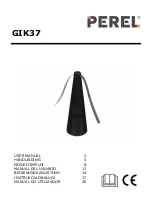
BC 2000 DIGITAL
Audio Routing, Mixing and Processing System for Program Production Centres
.
ARENA DM CONTROL SURFACE
FUNCTIONAL DESCRIPTION
24
3.1.6. Select: Access to the special functions display and controls.
Press the “Select” (12) pushbutton / indicator to associate the channel with the main
display (20) and controls (21) and (22), whose operation is discussed in Chapter 3.2
of this manual. In the special “
Bus Send Mode
” working mode, it will be an access
for direct routing of the signal present in each channel to the output bus associated
to this button in the configuration software. The “Select” menu is accessible in this
mode through the button that give access to “Routing” in the standard operating
mode.
3.1.7. Cue: Cue function.
Pressing the CUE button (13), will send the channel’s signal to the cue meter, that is
the PFL digital internal bus. This meter is found on the level and configuration
display (4) on the DM module. The CUE signal can also be sent to some of the
available VU meters (VU-1 or VU-2) and it will always be sent to the cue speakers
(1). Other places the cue signal can be sent to are headphones and monitoring in
control and studio room. In the special “
Bus Send Mode
” working mode, it will be an
access for direct routing of the signal present in each channel to the output bus
associated to this button in the configuration software; in this mode, the sending to
CUE is done by pressing the lower open-closed channel button (see section 2.2). In
the “
Multiplex Mode
”, this button allows you to monitor the channel input signal.
3.1.8. On Air: Signal indicator.
The “On Air” (14) indicator lights up to indicate that a signal is being sent to an
output bus. When this indicator is lit up, it means that the channel is selected, i.e.,
the red button at the end of the channel (19) is lit and the channel fader (18) is also
lifted up.
3.1.9. Select / On: Routing encoder and associated pushbutton.
The rotary “Select” control and its associated pushbutton (15 and 16) let you control
preset sends and control the balance or panorama.
By default, this control is assigned the balance or panorama function (depending on
whether the signal controlled by the channel is stereo or mono), and the associated
On
switch lets you activate spatial positioning or eliminate it (if it is available from the
configuration software), thus centering sends at 50% between L and R.
The channel label display (17) shows the outputs to which the signal controlled by
the channel can be sent at any time. By default, this display will show the L - R label
with an indication of the relative position between the L bus and the R bus:
L ..........|.......... R
When the encoder (15) is pressed and turned, each of the preassigned in the
configuration software as visible outputs will be shown. Pressing again the shown
output will be selected. The encoder now can regulate the send level to this output.
Each of these sends may be activated or deactivated separately, as the user wishes,
by means of the associated ON-OFF switch (16).
In the “
Multiplex Mode
”, the “Select” encoder regulates the return signal level, while
pressing the “On” button launches a PFL on the return signal.















































